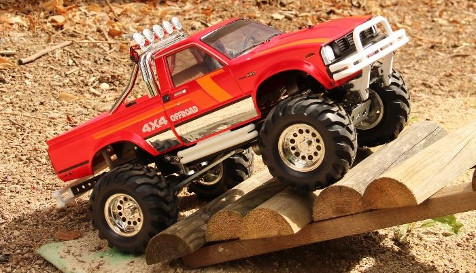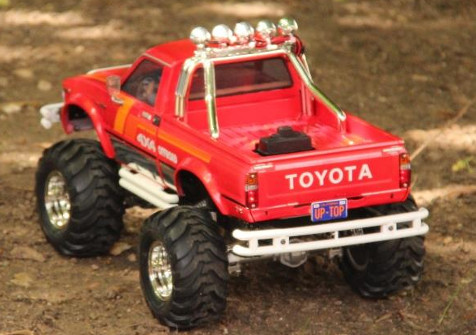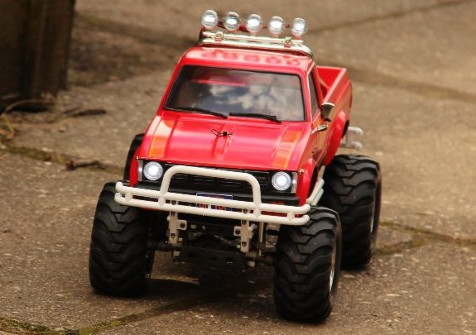First runs with the Toyota Mountain Rider
After several months dedicated to the exciting built, after many tests performed indoor (in order to validate one step, more often to “watch” the progress or to play with “test” the lights ![]() ), I waited until the first shiny days to take the Mountain Rider out. But first, here are some photos shot at the club with the stock wheels:
), I waited until the first shiny days to take the Mountain Rider out. But first, here are some photos shot at the club with the stock wheels:




Thank you Olivier!
With the stock tires, the Mountain Rider is limited to simple demonstration runs on somewhat even ground. The tires are so hard that the grip is very limited: on the other hand, you may drive the model for tens of kilometers on asphalt before the tires show the first signs of wear. However, even in these poor conditions, the driver enjoys watching the model run, changing gears and activating the light system from the radio. But even in these safe conditions, you need to keep focus and careful: the top speed in 2nd and 3rd gear is more than enough to flip the truck on its roof when cornering too fast.
Now let's change the environment: the Mountain Rider now goes into the wild with the option wheels.
For once, the photos truthfully depict my feeling when I shot them: once in its natural element, the Mountain Rider is present. Whereas I sometimes struggle to shoot my Mitsubishi Pajero so that it doesn't look “lost” in the scene, the Mountain Rider looks like it is standing there. Present. Of course, the 3Speed chassis is somewhat bigger than the CC-01 and the bigger wheels certainly help.
As for the handling, some may compare the Mountain Rider to a brick with suspension as soft as a leg in plaster and with the crawling ability of a stone. Not to forget about the overall balance that resembles a Weeble wobble with ballast in the head. To be honest, one must admit all this is quite true if you only consider the performance angle. Exactly, “performance” and "3 Speed” in the same sentence, it is a bit like “Jean Claude Van Damme” and “philosophy” put together: as dangerous as doing the splits ![]() .
.
This is the reason why assembling this mechanical wonder is so important and essential: first, because you will enjoy it, and second, you will understand the relative fragility of the transmission and the limits of the chassis abilities. Therefore, shifting gears should always be handled with care, that is avoiding to shift when the transmission is under heavy load. The driver should also be careful when cornering at speed in the 2nd or 3rd gear because the truck would certainly end on its roof. About this, I think it is a good advice to swap the stock Mabuchi 540 with something much cooler: I used a 35T motor, not for the extra torque but to dramatically reduce the top speed, even if there is still enough speed to flip the truck at full throttle in 3rd gear.
Once you understand and accept these parameters, the Mountain Rider and all Tamiya 3 Speed are wonderful models to drive in the woods. To improve the rides, locking the differentials and using much softer tires than stock do help a lot to climb things on your way:
Caution though, these are extravaganza (of some sort), not real abilities to rock crawling: the weight and high center of gravity are insuperable obstacles that will definitely prevent a Tamiya 3 Speed chassis from ever being a rock crawler, at least in stock form. As a matter of fact, whenever the slipper clutch goes into action is one signal the driver should never ignore. In fact, when the slipper clutch “slips”, it means the grip conditions become harder than the transmission can take. This situation generally happens when the conditions become “extreme” for the model, that is when the model is dangerously close to flip over. A careful driver who wants to preserve the bodyshell will learn to listen to the warning signal of the slipper clutch ![]() .
.
As a conclusion, even if I used the unflattering terms of "brick" and "stone" to describe with humor the Mountain Rider handling, do not think that I regret even one second buying this model. The fact is that it would be totally dishonest to compare a Tamiya 3Speed with modern productions: even today's “scalest“ models offer crawling abilities far beyond anything a 3Speed can pretend to. To fully appreciate a Tamiya 3Speed, you simply need to consider it for what is was at the time and for what it is still today in this re-released flavor: the greatest of mechanical realism and model in motion from the early 80's.
As a matter of fact, I consider this model as one of the most amazing in my collection. If you forget about RTR kits and if you allow me the use of shortcuts, RC could be described as enjoying building a model with one's own hands, to decorate it and to enjoy making it run. Well, a Tamiya 3Speed is like the best of all that: building the chassis is much more “mechanical” and complex than usual, and the ABS bodyshell requires more work and attention than the usual lexan ones (not to mention accessories like lights). The result is very close to the exact definition of a model in motion, this time with greater mechanical dimension: overall, the enjoyment is even greater when you contemplate the model running.
Related articles

















